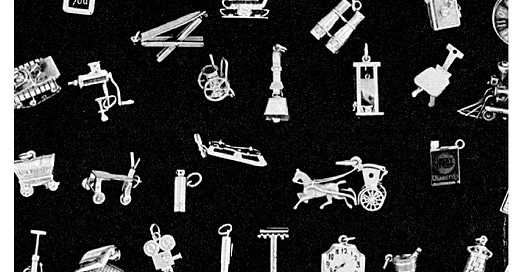That night, Lorna lay awake recalling the evening. When she closed her eyes she saw Buster’s face, his grin, his wink. She couldn’t get to sleep. She got out of bed. Herb was sleeping soundly. She put her robe on and walked down the hall. The bookcase that led to Mrs. Stolz’s room was closed. The door to Ella’s room was open. She was asleep, hugging her pillow. Lorna went to the living room. The embers barely glowed in the fireplace. She sat in the armchair at the far end of the room. For a while, she sat in the dark. Then she shook herself, told herself to act her age, switched the floor lamp on, and picked up a copy of Life. On the cover was a photograph of student nurses, apparently listening to a lecture. One caught her eye, the one in the lower right-hand corner. She wore an intent expression. She had dark, precisely plucked eyebrows, thin lips carefully rouged, and dark hair smoothly brushed.
I used to look like that, Lorna thought, when I was her age. She flipped the pages idly.
HOW RY-KRISP HELPED MARION TALLEY REDUCE
Reduce, Lorna thought. I should reduce.
WORLD’S BIGGEST BALL (200 ft.):
THEME CENTRE OF THE FAIR
That will be fun. It will be fun to go to the World’s Fair. There were photographs of models of statues to be erected on the fair’s central mall. Lorna admired the modeling of the musculature of a naked running man who symbolized Day, especially his calves and buttocks. She didn’t think much of the work on his hair, but she liked the purposeful expression on his face, the economical modeling of his lips and chin. She didn’t care at all for the woman meant to symbolize Night. Her features were vague, and her arms and legs were generalized and unattractive, the result, Lorna felt sure, of careless observation. Her belly looked soft, almost misshapen. Her breasts were flat and not especially feminine, redeemed only by her small, tight nipples. I can do much better work than that, Lorna told herself, and she was pleased to find that she felt uplifted by pride in her talent. She went on. She read an article about Germany that concluded, “Nazi Germany faces her destiny with the greatest war machine in history. And the inevitable destiny of the great war machines of the past has been to destroy the peace of the world . . . .” She flipped past an article on basketball in Indiana, past an advertisement for Old Overholt, Old Taylor, and Old Grand-Dad whiskies, and stopped at:
CAN YOU IDENTIFY
ALL THESE CHARMS?On this page is shown another phase of the mania for jingly, conspicuous jewelry. Here are 109 charms, reproduced slightly larger than life-size. Each is different. Although charms are as old as mankind, the present vogue dates back to the Big Depression. Customers of top-notch jewelers like Cartier, Marcus, or Udall & Ballou, found it a bit difficult to commemorate anniversaries with the usual precious stones. Instead they bought diminutive charms. The ladies liked them very much, clamored for more to string on bracelets and necklaces. In no time at all, charms began to appear in gold, silver and gilt. The charms on this page range in price from 10¢ to $330. Most of them are of gold, cost from $4 to $28 and have moving parts.
Moving parts. She examined the picture closely. What she saw struck her as crude work, terrible work. Why, I could make beautiful little charms, she thought. She flipped back to the article on the World’s Fair. I could even make statues. Didn’t Uncle Luther say I was an artist? She studied the muscles along Day’s flanks. She turned back to the charms. She held the intervening pages together and flipped back and forth between the statues and the charms. Moving parts, she thought. Moving parts. Why not? Why should I make coarse goods only for men? Why not coarse charms for women, really beautiful ones, ones that anyone would be proud to wear? Well, to wear on certain occasions. But why not?
[to be continued on Tuesday, September 27, 2022]
In Topical Guide 347, Mark Dorset considers Literature: Magazines: Popular or Mass-Market: Life; and Epigrams and Aphorisms: Plus ça change, plus c’est la même chose from this episode.
Have you missed an episode or two or several?
You can begin reading at the beginning or you can catch up by visiting the archive or consulting the index to the Topical Guide.
You can listen to the episodes on the Personal History podcast. Begin at the beginning or scroll through the episodes to find what you’ve missed.
You can ensure that you never miss a future issue by getting a free subscription. (You can help support the work by choosing a paid subscription instead.)
At Apple Books you can download free eBooks of “My Mother Takes a Tumble,” “Do Clams Bite?,” “Life on the Bolotomy,” “The Static of the Spheres,” “The Fox and the Clam,” “The Girl with the White Fur Muff,” “Take the Long Way Home,” “Call Me Larry,” and “The Young Tars,” the nine novellas in Little Follies, and Little Follies itself, which will give you all the novellas in one handy package.
You’ll find overviews of the entire work in An Introduction to The Personal History, Adventures, Experiences & Observations of Peter Leroy (a pdf document) and at Encyclopedia.com.





